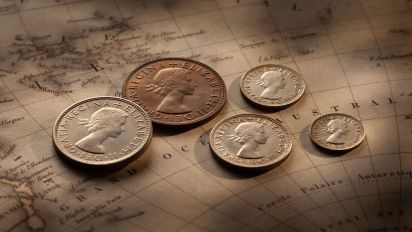The 'Chase Manhattan' Presentation Set struck in 1953 at the Melbourne Mint depicting the new obverse portrait of Queen Elizabeth II



Each coin has been carefully examined and we make the following comments.
A product of a controlled striking, the Specimen 1953 Florin is beautifully struck, with superb detail in all its design elements, including the edge denticles. The coin has original silver brilliance, smooth fields and quite beautiful subtle pale blue toning through the top part of the legend.
The Specimen 1953 Shilling is stunning and, to the naked eye, you would be forgiven for thinking that it was a proof coin. The surfaces are superb, with again quite beautiful subtle pale blue toning through the periphery on both obverse and reverse. Striations are noted on the obverse.
The Specimen 1953 Sixpence is, as with the shilling, well struck and stunning.
The Specimen 1953 Threepence is also a superb coin with original silver brilliance. There are heavy striations on the obverse reflecting careful die preparation.
The Specimen 1953 Penny is well struck, smooth surfaces and underlying copper brilliance on both obverse and reverse. The coin shows stunning luminous colours when moved through the light. Again, it is a visually impactful coin. Striations on the obverse are noted.
The Melbourne Mint achieved extraordinary quality with its 1953 specimen set. And this comment extends to the die preparation, the planchets, the quality of the strike and the precision achieved in the denticles. We note the set offered in the Max Stern October 1975 catalogue was described as a 1953 Proof Set!
The 1953 'Chase Manhattan' Set is is an extremely rare coin issue with only twelve units produced, exported in its entirety to the Chase Manhattan Bank in New York for their Currency Museum.
The set also is extremely rare in the context of the series to which it belongs. The issue was produced on a commercial basis, struck to order for Queen Elizabeth's coronation in 1953 and was sold to the bank in New York.
The Royal Australian Mint's release of decimal coin sets every year may have some collectors believing that pre-decimal sets were produced with the same regularity.
The reality is, over the period, 1916 to 1953 there were only four years in which the Melbourne Mint produced coin sets on a commercial basis.
The year '1953' is one of the four.
The Melbourne Mint in William Street was opened in 1872 as a branch of the Royall Mint London to strike Australia's gold sovereigns and half sovereigns. The mint diversified its coining repertoire in 1916 when it was commissioned by Treasury to strike Australia's Commonwealth silver coinage.
As the servant of Treasury, the Melbourne Mint became a prolific producer of coins for circulation.
The notion of producing limited edition pieces for collectors was not on the mint's agenda and over the next four decades (1916 to 1953) the Melbourne Mint produced only four coin sets for sale to the public.
• 1916 George V Specimen Set
Commemorating the inaugural striking of the Commonwealth's silver coinage at the Melbourne Mint. Only seven sets (in their original presentation case) have been offered over the last fifty years.
• 1934 George V Proof Set
The only Proof Set struck for King George V. Only ten sets have appeared at public auction over the last fifty years.
• 1938 George VI Proof Set
A reflection of the numbers struck, the George VI 1938 Proof Set is slightly more readily available with twenty sets sighted on the open market. Many of these have now been broken down and sold off as individual coins.
• 1953 Queen Elizabeth II, Specimen Set
The rarest by far of the commercial sets struck at the Melbourne Mint with only four sighted on the open market over the last fifty years.
© Copyright: Coinworks